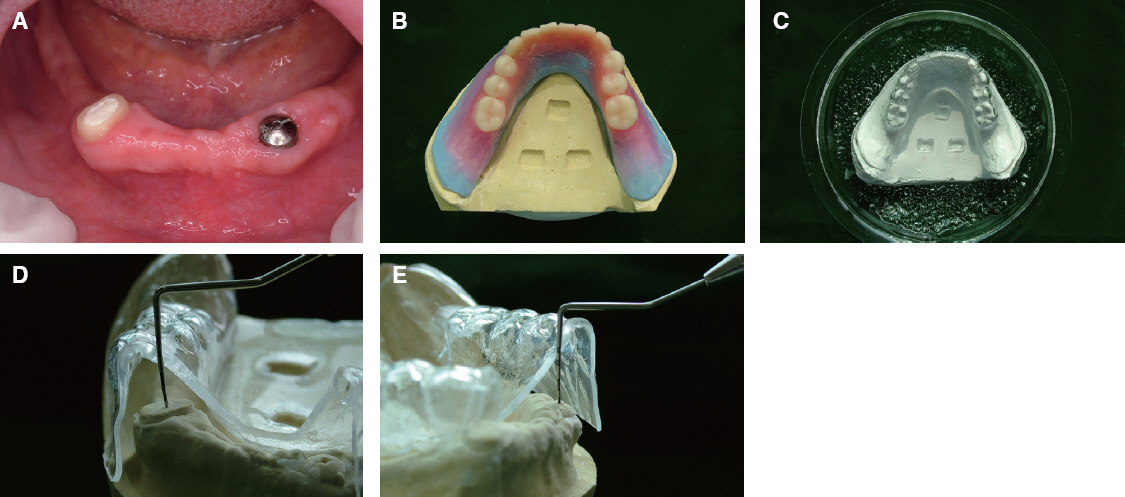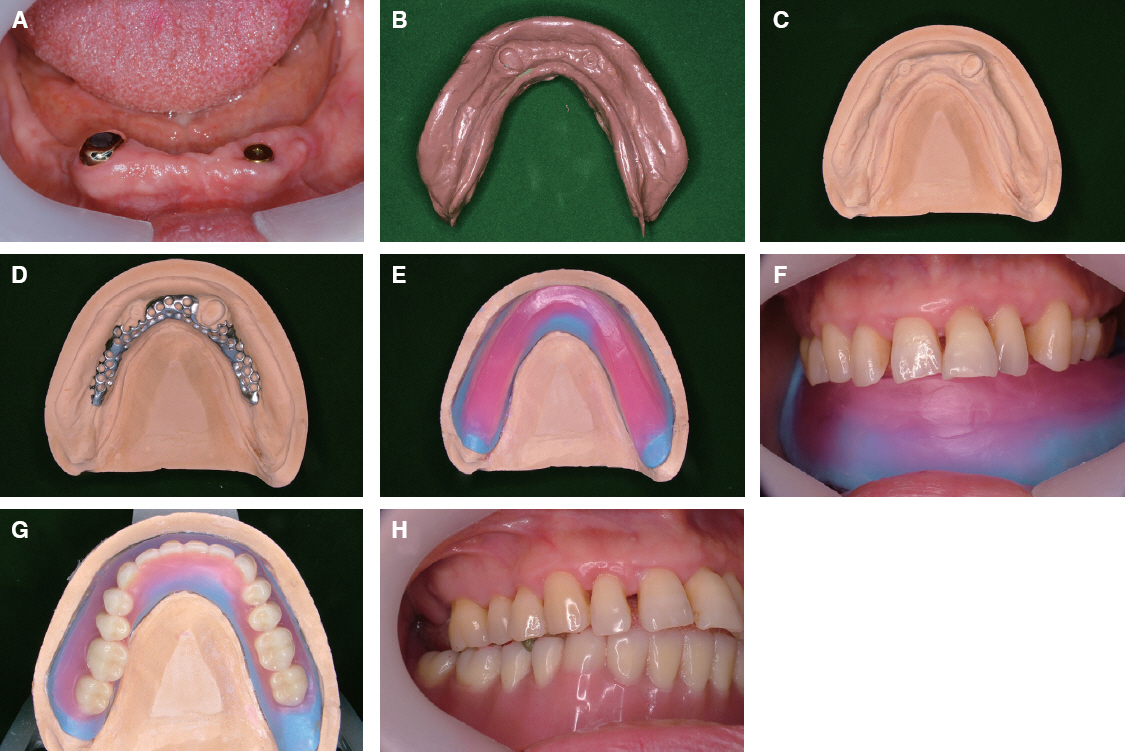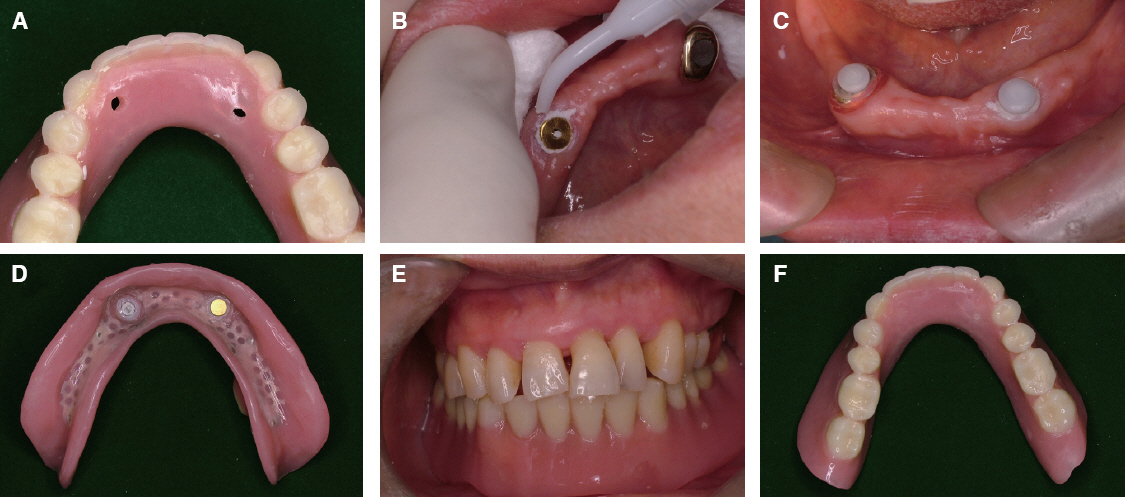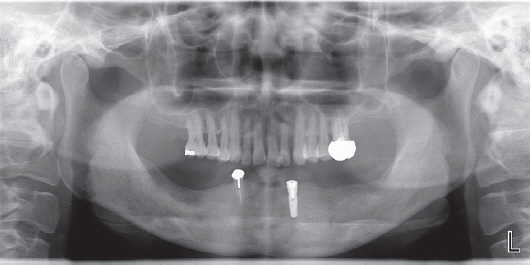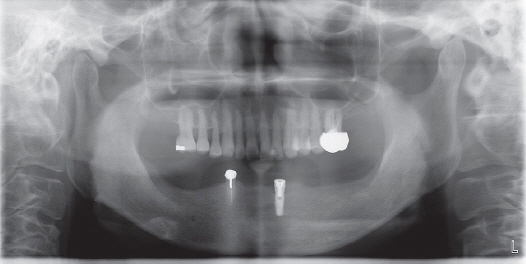J Dent Rehabil Appl Sci.
2015 Dec;31(4):378-386. 10.14368/jdras.2015.31.4.378.
Mandibular implant-natural tooth retained overdenture using magnetic attachment with stress breaker
- Affiliations
-
- 1Department of Prosthodontics, School of Dentistry, Chosun University, Gwangju, Republic of Korea. khjdds@chosun.ac.kr
- KMID: 2150203
- DOI: http://doi.org/10.14368/jdras.2015.31.4.378
Abstract
- Overdenture has the advantage of improving the stability and retention of the denture but the abutment may be easily affected by caries or periodontal disease and the thin denture can be easily broken. The magnetic attachment overdenture has a high vertical retention but a low horizontal retention, thus, exerting a less disruptive force to the abutment or implant and shows less abrasion or damage compared to other mechanical retainers. Denture fractures in overdenture is caused by the thin denture base as the attachment is inserted, but it may also be caused by the difference in detrusion between soft tissue and hard tissue, and between an implant and a natural tooth. To compensate this shortcoming, a magnetic attachment with a silicone ball inserted in the magnet was developed as we report a successful case using this specific type of magnetic attachment overdenture.
Keyword
MeSH Terms
Figure
Reference
-
References
1. Fueki K, Kimoto K, Ogawa T, Garrett NR. Effect of implant-supported or retained dentures on masticatory performance:a systematic review. J Prosthet Dent. 2007; 98:470–7. DOI: 10.1016/S0022-3913(07)60147-4.2. Fitzpatrick B. Standard of care for the edentulous mandible:a systematic review. J Prosthet Dent. 2006; 95:71–8. DOI: 10.1016/j.prosdent.2005.11.007. PMID: 16399278.3. Kim HY, Shin SW, Lee JY. Standardizing the evaluation criteria on treatment outcomes of mandibular implant overdentures:a systematic review. J Adv Prosthodont. 2014; 6:325–32. DOI: 10.4047/jap.2014.6.5.325. PMID: 25352954. PMCID: PMC4211048.4. Lord JL, Teel S. The overdenture:patient selection, use of copings, and follow-up evaluation. J Prosthet Dent. 1974; 32:41–51. DOI: 10.1016/0022-3913(74)90097-3.5. Takanashi Y, Penrod JR, Lund JP, Feine JS. A cost comparison of mandibular two-implant overdenture. Int J Prosthodont. 2004; 17:181–6. PMID: 15119869.6. Tokuhisa M, Matsushita Y, Koyano K. In vitro study of a mandibular implant overdenture retained with ball, magnet, or bar attachments:comparison of load transfer and denture stability. Int J Prosthodont. 2003; 16:128–34. PMID: 12737242.7. Ichikawa T, Horiuchi M, Wigianto R, Matsumoto N. In vitro study of mandibular implant-retained overdentures:the influence of stud attachments on load transfer to the implant and soft tissue. Int J Prosthodont. 1996; 9:394–9. PMID: 8957878.8. Kimoto S, Pan S, Drolet N, Feine JS. Rotational movements of mandibular two-implant overdentures. Clin Oral Implants Res. 2009; 20:838–43. DOI: 10.1111/j.1600-0501.2009.01723.x. PMID: 19531106.9. Sheets CG, Earthman JC. Tooth intrusion in implant-assisted prostheses. J Prosthet Dent. 1997; 77:39–45. Review. Erratum in:J Prosthet Dent 1997; 77:453. DOI: 10.1016/S0022-3913(97)70205-1.10. Elsyad MA, El-Waseef FA, Al-Mahdy YF, Fouad MM. A comparison of mandibular denture base deformation with different impression techniques for implant overdentures. Clin Oral Implants Res. 2013; 24(Suppl A100):127–33.11. Gonda T, Maeda Y, Walton JN, MacEntee MI. Fracture incidence in mandibular overdentures retained by one or two implants. J Prosthet Dent. 2010; 103:178–81. DOI: 10.1016/S0022-3913(10)60026-1.12. Dong J, Ikebe K, Gonda T, Nokubi T. Influence of abutment height on strain in a mandibular overdenture. J Oral Rehabil. 2006; 33:594–9. DOI: 10.1111/j.1365-2842.2005.01602.x. PMID: 16856957.13. Goodacre CJ, Kan JY, Rungcharassaeng K. Clinical complications of osseointegrated implants. J Prosthet Dent. 1999; 81:537–52. DOI: 10.1016/S0022-3913(99)70208-8.14. Assunção WG, Tabata LF, Barão VA, Rocha EP. Comparison of stress distribution between complete denture and implant-retained overdenture-2D FEA. J Oral Rehabil. 2008; 35:766–74. DOI: 10.1111/j.1365-2842.2008.01851.x. PMID: 18482352.15. Rissin L, House JE, Manly RS, Kapur KK. Clinical comparison of masticatory performance and electromyographic activity of patients with complete dentures, overdentures, and natural teeth. J Prosthet Dent. 1978; 39:508–11. DOI: 10.1016/S0022-3913(78)80181-4.16. Choi M, Acharya V, Berg RW, Marotta J, Green CC, Barbizam JV, White SN. Resinous denture base fracture resistance:effects of thickness and teeth. Int J Prosthodont. 2012; 25:53–9. PMID: 22259797.17. Gonda T, Ikebe K, Ono T, Nokubi T. Effect of magnetic attachment with stress breaker on lateral stress to abutment tooth under overdenture. J Oral Rehabil. 2004; 31:1001–6. DOI: 10.1111/j.1365-2842.2004.01324.x. PMID: 15387841.18. Sadowsky SJ, Caputo AA. Effect of anchorage systems and extension base contact on load transfer with mandibular implant-retained overdentures. J Prosthet Dent. 2000; 84:327–34. DOI: 10.1067/mpr.2000.109378. PMID: 11005906.19. Weinberg LA. The biomechanics of force distribution in implant-supported prostheses. Int J Oral Maxillofac Implants. 1993; 8:19–31. PMID: 8468083.20. Mühlemann HR. Tooth mobility:a review of clinical aspects and research findings. J Periodontol. 1967; 38:686–713. DOI: 10.1902/jop.1967.38.6_part2.686. PMID: 4867300.
- Full Text Links
- Actions
-
Cited
- CITED
-
- Close
- Share
- Similar articles
-
- 3D finite element analysis of overdenture stability and stress distribution on mandibular implant-retained overdenture
- The Implant Retained Overdenture by Locator Attachments on the Edentulous Mandible: A Case Report
- A PHOTOELASTIC ANALYSIS ON TOOTH SUPPORTING STRUCTURE AND RESIDUAL RIDGE ACCORDING TO DENTURE DESIGN FOR REMAINING MANDIBULAR CANINES
- Mandibular implant overdenture using Locator R-Tx attachment: A case report
- Maxillary implant-supported overdenture with magnetic attachment using healing abutment: A case report






